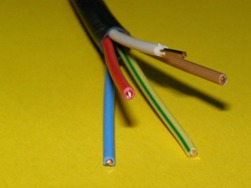Categories: Featured Articles » Electrician Secrets
Number of views: 68496
Comments on the article: 10
Which cable is better - flexible or rigid?
 When planning electrical work, in particular when it is necessary to select cable and wire products, the question arises of choosing between a flexible and a hard cable. In this article, we consider which cable better: flexible or rigid, depending on local conditions.
When planning electrical work, in particular when it is necessary to select cable and wire products, the question arises of choosing between a flexible and a hard cable. In this article, we consider which cable better: flexible or rigid, depending on local conditions.
First, consider what a flexible and rigid cable is. The flexible cable is multi-core, which provides it with sufficient flexibility. A rigid cable is single core, that is, its conductive core consists of one conductor.
The main distinguishing feature of a flexible cable from a rigid one is the possibility of bending it an unlimited number of times, as well as the ease of bending.
Mono-core cable is not intended for frequent bends, it can be bent a certain number of times, after which its conductive core will break. For example, a new copper rigid cable is able to withstand 80 bends, and aluminum - 12 bends. Over time, the fracture resistance of a single-core cable decreases.
Based on this, we can conclude that the flexible cable is selected if it is necessary to connect mobile power consumers. A hard cable is preferred if the power receivers connected to the power supply have a fixed position, that is, they are not subject to constant movement.
Below we consider the features of using flexible and rigid cable in everyday life and in electrical installations.
Flexible and rigid cable in home wiring
The electrical wiring of the apartment provides power to sockets, switches and lighting devices. These elements have a fixed position, therefore, for the installation of home wiring, they prefer a rigid cable. But in this case, it is not forbidden to mount the wiring with a flexible cable.
If the flexibility of the cable in home wiring does not matter, then accordingly there will be no difference in the operation of the flexible and rigid cable. But when choosing between a flexible and a rigid cable, the time and material costs of installing electrical wiring should be taken into account.
The advantage of a flexible cable is that it is much simpler. stow, cable channelas well as directly in the junction box or shield. But during the installation of electrical wiring, in particular when connecting a flexible cable in the switchboard to protective devices and terminal blocks, to the switches, sockets and lighting devices, it is necessary to terminate the cable cores.
The termination of the cores of the flexible cable is carried out by special crimp lugs or by soldering them. Accordingly, when choosing a flexible cable for wiring, it is necessary to spend additional time on cable termination and funds on the acquisition of crimp lugs, crimp tools. In addition, a flexible cable is much more expensive than a hard cable.
A single-core cable in this case has an advantage, since its conductors are connected to the above wiring elements immediately after removing the insulating layer, without additional preparation (crimping with lugs, soldering), and when connecting in junction boxes, a multi-core cable is much easier to weld or crimp with sleeves.
One of the advantages of a flexible cable in home wiring is fracture resistance with frequent reconnection of the wire when replacing sockets, a switch or a lamp. But, subject to the selection of reliable sockets, switches, fixtures, the correct selection of protective devices, as well as subject to the rules for the operation of electrical wiring, a hard cable lasts quite a long time, since reconnecting the cable and, accordingly, bending it is rather rare.
Flexible and rigid cable in electrical installations
In electrical installations of distribution substations, industrial enterprises, a rigid cable is used to connect stationary equipment, auxiliary circuits for various purposes.Flexible cable in electrical installations is mainly used when connecting circuits inside switchboards for various purposes, in relay protection cabinets and automation equipment of substations. A hard cable can also be selected for this purpose.
In this case, it all depends on the design of the connected element. For example, in relay protection and automation cabinets, a flexible wire is used to connect secondary circuits to microprocessor protection terminals, since connecting a hard cable can damage the terminals of the device.
The flexible cable in the workshops of the enterprise is used to connect mobile power tools, welding machines and other electrical equipment that does not have a fixed location. Also, a flexible cable is used to power individual moving units that are available in the design of a particular item of equipment, for example, in a machine.
A rigid, single-core cable has a limited bending radius, so if you need to lay the cable at an angle close to a straight line, you prefer a flexible cable that can bend at a small radius.
It should be noted that the flexibility of the cable may be different. There are seven classes of cable flexibility. The higher the class, the higher the cable flexibility: the first class of flexibility corresponds to a single-core cable, the seventh class corresponds to the most flexible. As for the cost of the cable, the higher its flexibility class, the more expensive it is.
See also at bgv.electricianexp.com
:

